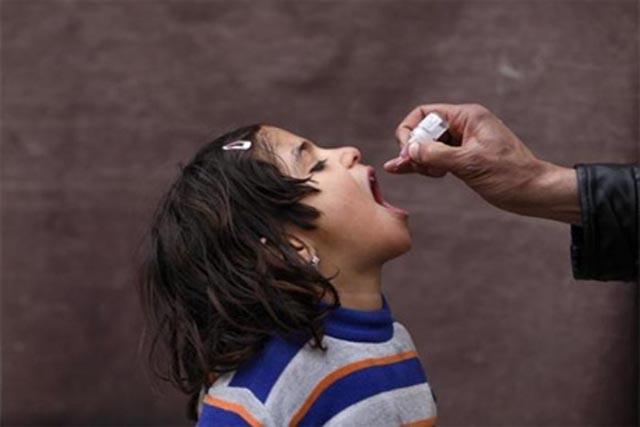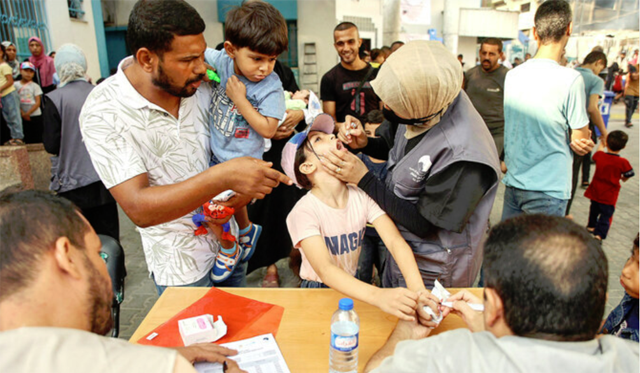You are here
Combining vaccines boosts polio immunity
By AP - Aug 26,2014 - Last updated at Aug 26,2014

WASHINGTON — New research suggests a one-two punch could help battle polio in some of the world’s most remote and conflict-torn regions: Giving a single vaccine shot to children who’ve already swallowed drops of an oral polio vaccine greatly boosted their immunity.
The World Health Organisation officials said the combination strategy already is starting to be used in mass vaccination campaigns in some hard-hit areas and is being introduced for routine immunisations in developing countries.
“It could play a major role in completing the job of polio eradication once and for all,” said Dr Hamid Jafari, WHO’s director of polio operations, who led the study recently published in the journal Science.
Oral polio vaccine has played a critical role in the nearly three-decade effort to eradicate the paralysing disease, as health workers have gone house-to-house, to refugee camps and to roadside checkpoints delivering the drops. The number of countries where polio regularly circulates dropped from 125 in 1988 to just three as of last year —Pakistan, Nigeria and Afghanistan.
But with travel, the threat is re-emerging in countries previously free of the highly contagious virus. The WHO in May declared an international public health emergency, citing outbreaks in at least 10 countries. Particularly of concern were Syria, Somalia and Iraq, where violence has complicated efforts to contain new cases.
Which vaccine to use in the eradication push has long been controversial. They each have different strengths. The United States and other wealthy countries have switched back to using only injected polio vaccine, which is made of “inactivated” or killed virus, for routine childhood immunisations after eradicating the disease within their borders. That’s because the oral vaccine contains weakened live virus that children can shed in their stools, which on very rare occasions can trigger a vaccine-caused case of polio.
In developing countries where polio is still a threat, the oral version is cheaper, easier to use and can slow spread of the virus. But a particular type of immunity, intestinal immunity, wanes so that children in high-exposure areas need repeated doses.
Jafari’s team tested whether using both vaccines would protect better than one. The study involved nearly 1,000 children, from babies to 10-year olds, in northern India in 2011, the last year that country reported a case of polio. The children had previously received oral vaccine. This time, they were randomly assigned to receive a dose of injected polio vaccine, another oral dose or no booster. Four weeks later, they all received what researchers called a “challenge” dose of oral vaccine to see how their bodies shed the weakened live virus.
The shots acted as a better booster for the children’s intestinal immunity than giving them yet more vaccine drops — and those youngsters shed far less virus, key to cutting transmission in an outbreak, Jafari’s team reported.
A similar study in 450 children in southern India last year reached the same conclusion, researchers reported in The Lancet last month.
And last December, Kenya put the strategy to its first real-world test. Health workers used both injected and oral vaccine as they sought to immunise 126,000 young children living in Somali refugee camps and nearby areas who were at risk from a polio outbreak spilling over the Somalia-Kenya border. They reached most of the children, according to a report by the US Centres for Disease Control and Prevention.
Similar campaigns are beginning in northeastern Nigeria and should start soon in Pakistan, said Jafari and Dr Bruce Aylward, WHO’s assistant director-general for polio.
The injected vaccine is more expensive, Aylward said — about $1 to $1.90 a shot, under specially negotiated prices for low-income countries, compared to about 15 cents a dose for oral vaccine. But he said it was worth the investment if adding the shots wound up eliminating polio in the last infected areas faster.
Using this strategy in these tough-to-reach areas makes sense, said CDC vaccine expert Dr Steve Cochi.
“We want to take maximum advantage of each contact with a child,” he said. “It’s the start of the last stand for wild polio virus, and we’re trying to hit it with both vaccines.”
At the same time, the WHO has called on low- and middle-income countries that now use only oral polio vaccine to add one dose of the injected version to routine childhood immunisations next year.
Related Articles
The Ministry of Health on Sunday urged Jordanians and residents of the Kingdom to immunise their children aged five years and younger against polio as part of a nationwide campaign.
GENEVA — The World Health Organisation said Wednesday that mass polio vaccination would resume in Gaza on Saturday, targeting nearly 6
With a new anti-polio immunisation campaign slated for the end of November in Jordan, officials and UN agency representatives have called for focusing on Syrians residing outside refugee camps.












